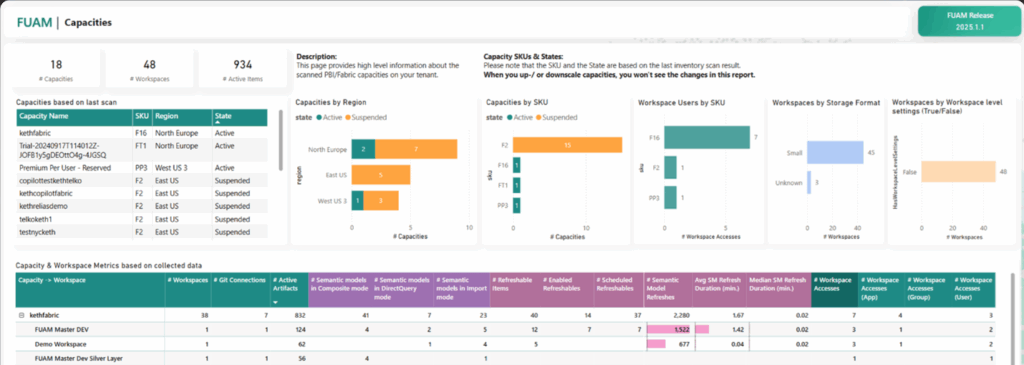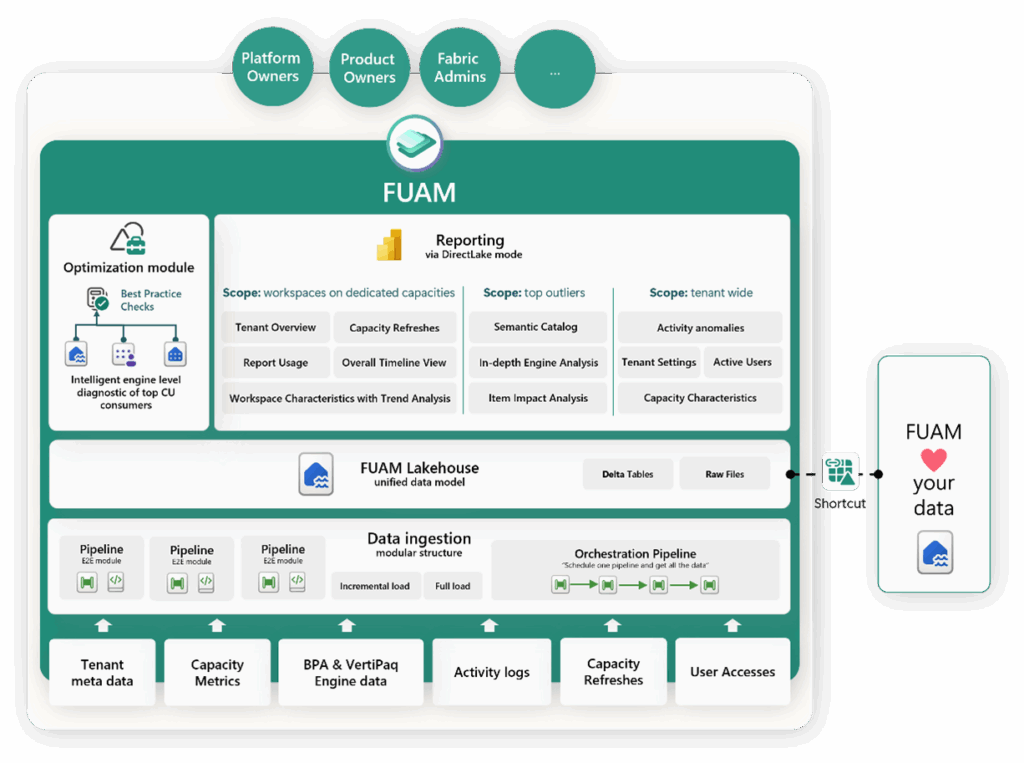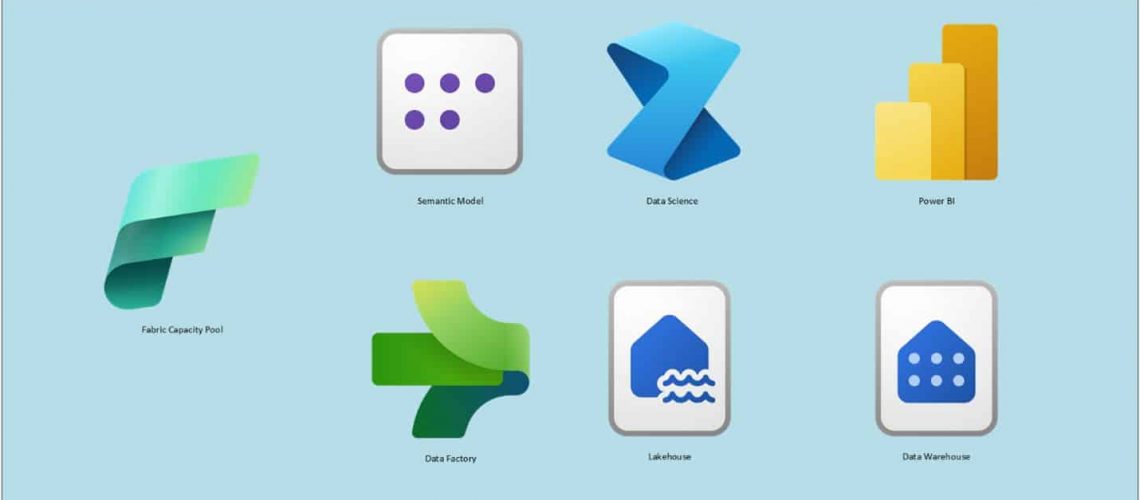Using Microsoft Fabric without a way to track your capacity usage is like driving a sports car with no dashboard. Sure, it’s got power—but without seeing what’s going on under the hood, you might burn fuel, money, or both. FUAM provides a dashboard. You can see how your Fabric environment is doing and improve its efficiency.
FUAM: Fabric Unified Admin Monitoring
This article looks at FUAM, or Fabric Unified Admin Monitoring. It helps you see how Microsoft Fabric is used in your workflows. It’s made for tech-savvy leaders and data teams. They want to boost efficiency and avoid guessing on spending. FUAM helps you track how much capacity you use. It shows where you can save and helps you make better decisions using real data, not just guesses.
A major benefit of Microsoft Fabric is that it combines all your analytics tasks into one platform. This includes data engineering (ETL), business intelligence (BI), machine learning, and real-time analytics. Everything operates in one environment. This way, you don’t have to manage many tools and infrastructure pieces. There’s a trade-off: all these jobs use the same compute pool, measured in Capacity Units (CUs). Every refresh, query, or process you run adds to your usage and your cost.
That’s where the costs come in. With Reserved Capacity, you pay a flat rate. With PAYG (Pay-As-You-Go), you’re billed by the minute. Either way, it’s easy to pay for capacity you don’t fully use.
In reality, many companies’ over-provision “just to be safe,” then don’t watch usage closely. That’s like leaving your car running all weekend in case you need to drive on Monday.
FUAM: Your Cost Visibility Layer

Fabric Unified Admin Monitoring (FUAM) provides a clear view of your Microsoft Fabric environment. It shows usage and costs in one simple place. Instead of switching between tools and reports, FUAM brings it all together. It highlights which platform parts use the most capacity and when usage peaks. It also identifies areas where spending may be high. Whether you track a few projects or manage many teams, FUAM gives you both the big picture and the details. This way, you can make informed decisions that save costs.
FUAM pulls together components that are constructed solely with native Microsoft Fabric tools.
- Capacity usage over time (who’s using what, when, and how much)
- Refresh activities and failures.
- Workspace and dataset inventories.
- User activity and trends.
- Admin settings and audit changes.
This unified view helps you answer practical questions, like:
- Are we using the capacity we’re paying for?
- Can we shift workloads to off-peak hours to save?
- Which teams or projects are driving costs?
And most importantly, where can we spend smarter?
5 Ways FUAM Helps You Cut Costs

Here’s how FUAM helps you manage your Fabric investment:
1. Right-Size Your Capacity
FUAM shows how many Capacity Units (CUs) your organization uses daily. For instance, if you have an F128 capacity but only reach 60 CUs at peak, you’re paying for more than double the resources you need. Switching to a smaller tier like F64 can cut your monthly costs in half without hurting performance. FUAM offers data to help you decide with confidence. This aligns your spending with how much you actually use.
2. Pause When You Don’t Need It
FUAM makes it easy to see when your capacity isn’t being used, like during evenings, weekends, or holidays. If you have a PAYG (Pay-As-You-Go) plan, here’s a tip: you can pause your capacity during slow times. This way, you won’t pay for resources you don’t need. You can still use off-peak hours with Reserved Capacity. Just shift heavy jobs, like data loads or batch reporting, to those off-peak hours. Either way, FUAM helps you plan smarter and squeeze more value out of every CU you’re paying for.
3. Find the Budget Sinkholes
Some analytics jobs quietly chew up your compute capacity without delivering much value. For example, you may have datasets that refresh every hour, even if the data changes just once a day. Also, some workspaces might sit unused for months but still use resources. FUAM helps you spot these inefficiencies quickly. It flags too many refreshes, idle or abandoned workspaces, and datasets that waste capacity. Think of it as a cleanup checklist for your data. It helps you tidy up, cut waste, and ensure you only pay for what adds value.
4. Make Informed Trade-offs
FUAM lets you explore different cost-saving strategies before making a change. Want to see if switching from Reserved to PAYG would save money? Want to know how auto-scaling can handle your usage spikes? FUAM gives you historical and real-time data for virtual testing, like a simulation. You can compare costs side by side based on your actual usage patterns. This approach eliminates guesswork. You’ll make informed choices based on real data that fit your budget and workload needs.
5. Keep Governance Tight
FUAM monitors activity and key settings in your Fabric environment. Small changes can matter a lot. For example, if you enable preview features or misconfigure permissions, it can cause overuse or unexpected costs. FUAM flags these mistakes so you can fix them quickly. It acts as a safety net. It helps keep your environment safe, efficient, and in line with the best governance practices.
Easy to Deploy, Built for Efficiency

FUAM is completely free and open source, so there’s no licensing cost to get started. It’s even better because it uses tools you likely already know. You can create interactive dashboards with Power BI. Data Pipelines help automate data movement. Notebooks let you run code and make transformations. Plus, Lakehouse storage organizes your monitoring data. You install it right in your Microsoft 365 setup. This keeps everything secure and private. You stay in control—no need for outside tools or vendors. It’s easy to deploy, quick to set up, and designed to fit into your current workflow with minimal effort. FUAM helps small teams and mid-sized companies track and manage their Fabric costs with ease.
Setup usually takes a day. Once running, it’s lightweight and low-maintenance.
Want to customize it? FUAM is built to be flexible. Its modular design makes it easy to expand or tweak based on your organization’s needs. You can tag usage by cost center. This lets departments track and manage their spending. You can also import Azure billing data to link usage with actual charges. This gives you a clearer view of your expenses. If teams or leaders need specific views, you can create custom dashboards using FUAM’s semantic model. There’s no need to start from the beginning. It’s designed to adapt to your priorities and evolve with your business.
What Cost Savings Look Like in Practice

One mid-sized company installed FUAM and found it was:
- Running an F128 but never exceeding 40 CUs.
- Using almost no capacity on nights and weekends.
- Refreshing datasets multiple times a day with no real need.
After 60 days:
- They downsized to F64, cutting compute costs by 50%.
- They rescheduled refreshes to run overnight.
- They paused weekend capacity usage entirely.
FUAM gave them visibility and confidence to act—and the results showed up in the next billing cycle.
Getting Started: Simple Steps to Savings
You don’t need a dedicated cloud economics team to rein in costs. You just need to get FUAM running. Here’s how:
- Deploy FUAM in a Fabric workspace (start with the provided setup notebook).
- Run the pipeline to collect baseline data.
- Review the Power BI reports to identify the top savings opportunities.
- Make small changes—pause capacity, clean up stale content, adjust refresh frequency.
- Track progress and tune as you go.
Wrap-Up: Spend Smart, Not Blindly
Microsoft Fabric is a strong analytics platform. It does many things. But if you don’t keep an eye on its use, costs can rise quickly. You might be paying for capacity you’re not using, running jobs that no longer deliver value, or scaling infrastructure based on guesswork. That’s where FUAM comes in. It provides a real-time view of your Fabric resources. This helps you spot inefficiencies early. You can then take action and ensure your analytics spending supports real business results.
Bottom line: You’re already investing in Fabric. FUAM helps you get more out of every dollar.


